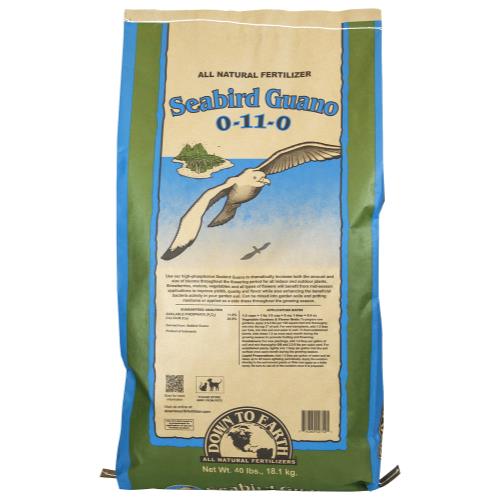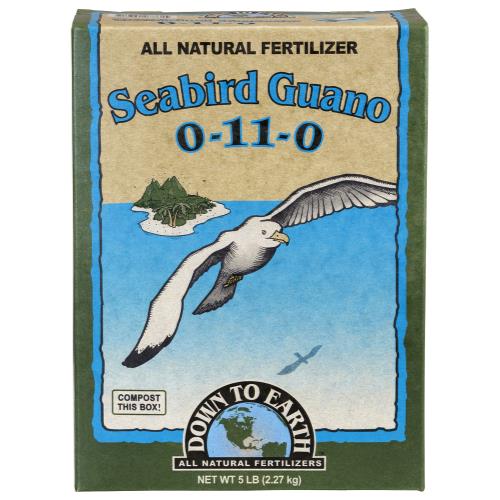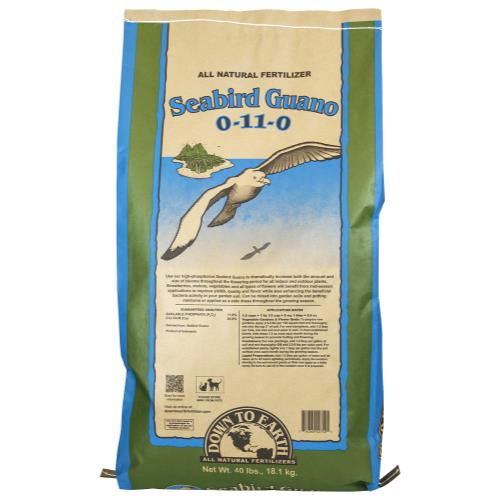Down To Earth
Down To Earth High Phosphorus Seabird Guano
Down To Earth High Phosphorus Seabird Guano
Low stock: 10 left
Couldn't load pickup availability
Payment options
- Fast Delivery
- Easy Returns
- Secure Checkout
Description
Description
Down To Earth High Phosphorus Seabird Guano is a natural and organic fertilizer that provides a powerful nutrient boost to plants, making it an excellent choice for flowering and fruiting crops. Derived from seabird guano, this product is rich in phosphorus, an essential nutrient for blooming and root development, along with other valuable nutrients and micronutrients. Gardeners and growers appreciate seabird guano for its effectiveness in promoting vigorous flowering, increased fruit production, and overall plant health.
Key Features:
1. High Phosphorus Content: Seabird guano is celebrated for its exceptional phosphorus levels, which play a crucial role in flower formation and root growth.
2. Rich in Nutrients: This guano contains essential nutrients such as nitrogen (N), phosphorus (P), and potassium (K), as well as valuable micronutrients.
3. Natural Source: Sourced from seabirds, it is an all-natural and organic product with minimal environmental impact.
4. Slow-Release: Offers a slow-release nutrient supply, ensuring plants receive nutrients over an extended period.
5. Versatile: Suitable for various plant types, including flowering, fruiting, and root crops.
6. Odor-Free: Unlike raw guano, this processed form is odor-free and easier to handle.
Benefits:
• Flowering Enhancement: High phosphorus content promotes prolific flowering and fruiting in plants.
• Root Development: Phosphorus is essential for robust root growth and plant establishment.
• Increased Yield: Plants treated with seabird guano tend to produce larger yields of fruits, flowers, and vegetables.
• Organic Gardening: Ideal for organic gardening, contributing to environmentally responsible and sustainable practices.
Applications:
Down To Earth High Phosphorus Seabird Guano can be used in various ways:
• Incorporate into Soil: Mix it into the soil before planting to ensure an even distribution of nutrients.
• Topdressing: Apply the guano to the soil surface around established plants, and then water it in.
• Transplanting: Use it when transplanting seedlings to provide a nutrient-rich environment.
Usage Instructions:
• Garden Beds: Apply 5-10 pounds of guano per 1,000 square feet and mix it into the topsoil.
• Container Plants: Use 1-2 tablespoons for smaller pots, and increase the amount for larger containers.
• Transplanting: Add a small amount to the planting hole for each new seedling.
Down To Earth High Phosphorus Seabird Guano is an exceptional choice for gardeners who want to enhance flowering, fruiting, and root development in their plants. This organic fertilizer offers the benefits of seabird guano in a convenient and odor-free form. Whether you’re cultivating ornamental flowers, fruit-bearing trees, or garden vegetables, this product can help you achieve bountiful and healthy crops while adhering to organic gardening practices.
Share


INFORMATION QUESTIONS
FREQUENTLY ASKED QUESTIONS
What is Hydroponics?
Hydroponics is the science of growing plants without soil. The plants thrive on the nutrient-water solution alone. The growing medium merely acts as a support for the plants and their root systems while the solution passes freely. The growing medium, if any, is totally inert.
What types of plants grow best hydroponically?
Anything can be grown hydroponically, but some plants prove to be more space efficient. Some plants we suggest are tomatoes, sweet peppers, hot chilies, lettuce, spinach, squash, cucumbers, broccoli, beans, snow peas, herbs and flowers of all types.
Can you REALLY get better yields/quicker growth?
Absolutely. The plants, when receiving everything they need, tend to be healthier, faster growing and generally more productive. You can expect 30% faster growth with many crops.
What are the watering cycle timelines hydroponic systems?
Once the reservoir is filled with nutrients, it is time to put your hydro system to work! The ease of hydroponics is automation – automation is achieved by putting the pump on a timer according to your watering needs. The watering cycle depends on growth stage, growing medium and hydroponic system. In an ebb and flow or drip system with rockwool as the medium, seedlings, clones and plants in the early vegetative stage require watering only once a day for 15-30 minutes (twice a day for higher temps). Mature, flowering and fruiting plants require a heavier feed and can be fed once a day for 30 minutes (twice a day for higher temps). Typically soiless mixes and coco fiber can be watered for about 15 minutes twice a day, and can be adjusted for heavier feeding during the flowering and fruiting stage or higher temps. ViaStone, Hydroton, Grow Rocks, and Silicate mediums need to be watered more frequently – a constant drip for drip systems, and about 15-30 minutes every 3 hours for ebb and flow systems and can be adjusted for heavier feeding during the flowering and fruiting stage or higher temps. Aeroponic systems require frequent watering cycles; 30-60 seconds every few minutes or a constant spray.
What do I need to test pH? How do I test pH?
pH has a range from 0 (acidic) – 14 (alkaline), with 7 being neutral. A proper hydroponic pH range is between 5.5 to 6.2 for most hydroponic crops. For specific crop pH, check out our Plant Guide. pH must remain within the proper range for good plant health, disease resistance, and proper nutrient uptake. pH is maintained by adding pH Up and pH Down to the nutrient solution. For more information, see the Testssection of our site.
How will the flavor compare to my outdoor grown, organic produce?
The taste may be even better! This is simply due to the fact that the hydroponically grown plants are getting everything they need, when they need it. Don’t be fooled by “hot house” produce grown commercially. The grower’s primary concern is shipability and storage, not flavor. When you grow your own vegetables at home, you can expect nothing less than excellent results. Plus, hydroponically grown produce has the added benefit of a longer shelf life.

